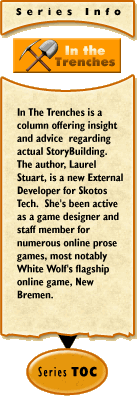
Storybuilding Quickstartby Laurel Stuart The past few weeks I've talked to a lot of enthusiastic folks who want to be game designers. Some had a specific story in mind, others less than that. Over the course of conversations, I began to articulate a process that I felt is well-suited for initial game design, that fundamental foundation that comes before actual Chat Theatre construction. 1. Create Your ParadigmGet out a blank sheet of paper and write down a list of everything you want your game to do/be and just as importantly what you want your game to -not- do/be. Don't worry about grammar or punctuation or run on sentences. Just get the thoughts from your head to the paper. It's helpful for me to take a sheet of paper and divide it into two columns and to write down everything that comes to mind. Here's an example, based on my initial notes for Devil's Cay.
The list can easily go on past a full page of more. The two keywords to articulating a game paradigm as as always sustainability and containability. Every rule, every NPC, every room and object needs to promote either or both of these traits. Mastering sustainability and containability will only come with practice, however. Outlining what your game should offer and promote is an excellent way to starting the process. 2. Choose a genreTravis Casey has been discussing game genres for months in his excellent series "Building Stories, Telling Games". You can find over there interesting tidbits regarding a number of game genres. Your game should have a genre, even if it's an amalgamation of several larger genres. Genres offer specific styles, forms and content that will enable all of the players to easily create their own interconnected stories. One of the hardest things to appreciate is that as a StoryBuilder, you are not writing a story. You are creating setting, premise and situations- what the players do, via their characters, will be interactive fiction. |
